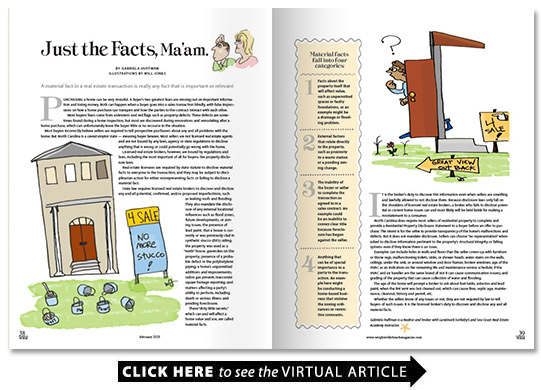Just the Facts Ma’am.
BY Gabriela Huffman
A material fact in a real estate transaction is really any fact that is important or relevant
Purchasing a home can be very stressful. A buyer’s two greatest fears are missing out on important information and losing money. Both can happen when a buyer goes into a sales transaction blindly with false impressions on how a home purchase can transpire and how the parties to the contract interact with each other.
Most buyers’ fears come from unknowns and red flags such as property defects. These defects are sometimes found during a home inspection but most are discovered during renovations and remodeling after a home purchase which can unfortunately leave the buyer little or no recourse in the situation.
Most buyers incorrectly believe sellers are required to tell prospective purchasers about any and all problems with the home. But North Carolina is a caveat emptor state — meaning buyer beware. Most sellers are not licensed real estate agents and are not bound by any laws agency or state regulations to disclose anything that is wrong or could potentially go wrong with the home.
Licensed real estate brokers however are bound by regulations and laws including the most important of all for buyers: the property disclosure laws.
Real estate licensees are required by state statute to disclose material facts to everyone in the transaction and they may be subject to disciplinarian action for either misrepresenting facts or failing to disclose a material fact.
State law requires licensed real estate brokers to discover and disclose any and all potential confirmed and/or proposed imperfections such as leaking roofs and flooding. They also mandate the disclosure of any external locational influences such as flood zones future developments or zoning issues; the presence of lead paint; that a house is currently or was previously clad in synthetic stucco (EIFS) siding; the property was used as a “meth” house; gravesites on the property; presence of a probable defect in the polybutylene piping; a home’s unpermitted additions and improvements; radon gas present; inaccurate square footage reporting; and matters affecting a party’s ability to perform including death or serious illness and pending foreclosure.
These “dirty little secrets ” which can and will affect a home value and use are called material facts.
It is the broker’s duty to discover this information even when sellers are unwilling and lawfully allowed to not disclose them. Because disclosure laws only fall on the shoulders of licensed real estate brokers a broker who fails to disclose potential or current home issues can and most likely will be held liable for making a misstatement to a consumer.
North Carolina does require most sellers of residential property to complete and provide a Residential Property Disclosure Statement to a buyer before an offer to purchase. The intent is for the seller to provide transparency of the home’s malfunctions and defects. But it does not mandate disclosure. Sellers can choose “no representation” when asked to disclose information pertinent to the property’s structural integrity or failing systems even if they know there is an issue.
Examples can include holes in walls and floors that the seller covers up with furniture or throw rugs; malfunctioning toilets sinks or shower heads; water stains on the walls ceilings under the sink or around window and door frames; broken windows; age of the HVAC as an indication on the remaining life and maintenance service schedule; if the HVAC and air handler are the same brand (if not it can cause communication issues); and grading of the property that can cause collection of water and flooding.
The age of the home will prompt a broker to ask about fuel tanks asbestos and lead paint; when the lint vent was last cleaned out which can cause fires; septic age maintenance cleanout history and permit etc.
Whether the sellers know of any issues or not they are not required by law to tell buyers of such issues. It is the licensed broker’s duty to discover and disclose any and all material facts.
Material facts fall into four categories:
1. Facts about the property itself that will affect value such as unpermitted spaces or faulty foundations or an example might be a drainage or flooding problem.
2. External factors that relate directly to the property such as proximity to a waste station or a pending zoning change.
3. The inability of the buyer or seller to complete the transaction as agreed to in a sales contract. An example could be an inability to convey clear title because foreclosure has begun against the seller.
4. Anything that can be of special importance to a party to the transaction. An example here might be conducting a home-based business that violates the zoning ordinances or restrictive covenants.
Gabriela Huffman is a Realtor and broker with Landmark Sotheby’s and Sea Coast Real Estate Academy Instructor.
